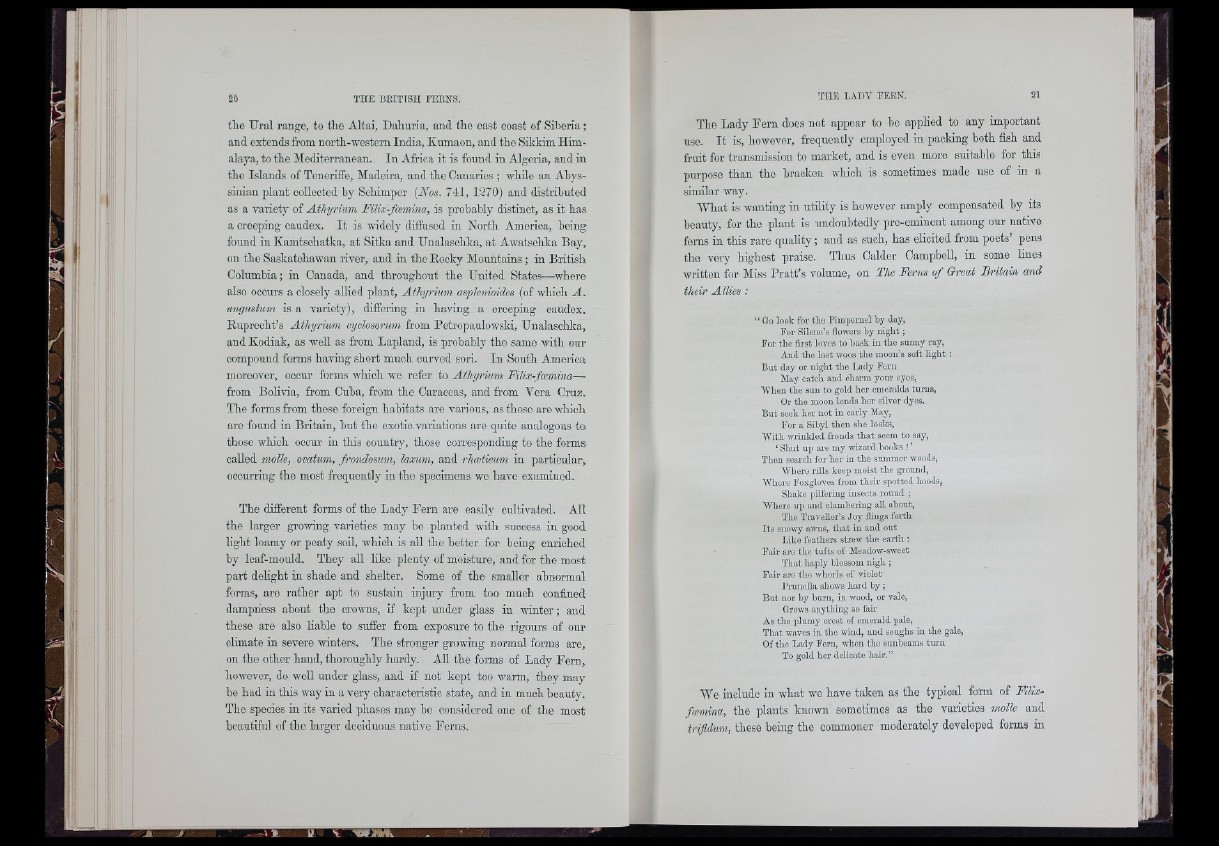
the Ural range, to the Altai, Dahuria, and the east coast of Siberia;
and extends from north-western India, Kumaon, and tbe Sikkim Himalaya,
to the Mediterranean. In Africa it is found in Algeria, and in
the Islands of Tenoriffe, Madeira, and the Canaries ; while an Abyssinian
plant collected by Sobimper (Abs. 741, 1270) and distributed
as a variety of AtJiyrmm Filix-fcemina, is probably distinct, as it has
a creeping caudex. It is widely diffused in North America, being
found in Kamtschatka, at Sitka and Unalasolilia, at Awatsohka Bay,
on the Saskatohawan river, and in the Eocky Mountains ; in British
Columbia; in Canada, and throughout the United States—where
also occurs a closely allied plant, Athyrium asplenioides (of which A .
angnstum is a variety), differing in having a creeping caudex.
Eupreoht’s Athyrium cyclosorum from Petropaulowski, Unalasohka,
and Kodiak, as well as from Lapland, is probably tbe same witb our
compound forms having short much curved sori. In South America
moreover, occur forms which we refer to Athyrium Filix-fcemina—
from Bolivia, from Cuba, from the Caracoas, and from Yera Cruz.
The forms from these foreign habitats are various, as those are which
are found in Britain, but tbe exotic variations are quite analogous to
those wbich occur in this country, those corresponding to the forms
called molle, ovatum, froncloswn, laxum, and rhcetimm in particular,
occurring the most frequently in the specimens we have examined.
The different forms of the Lady Fern are easily cultivated. All
the larger growing varieties may be planted with success in good
light loamy or peaty soil, wbiob is all the better for being enriched
by leaf-mould. They all like plenty of moisture, and for the most
part delight in shade and shelter. Some of the smaller abnormal
forms, are rather apt to sustain injury from too much confined
dampness about the crowns, if kept under glass in winter ; and
these are also liable to suffer from exposure to the rigours of our
climate in severe winters. The stronger growing normal forms are,
on the other hand, thoroughly hardy. All the forms of Lady Fern,
however, do weU under glass, and if not kept too warm, they may
be had in this way in a very characteristic state, and in much beauty.
The species in its varied phases may be considered one of tbe most
beautiful of the larger deciduous native Ferns.
The Lady Fern does not appear to he applied to any important
use. It is, however, frequently employed in packing both fish and
fruit for transmission to market, and is even more suitable for tbis
purpose than the bracken which is sometimes made use of in a
similar way.
■\Yhat is wanting in utihty is however amply compensated by its
beauty, for the plant is undoubtedly pre-eminent among our native
ferns in this rare quality; and as such, has elicited from poets’ pens
the very highest praise. Thus Oalder Campbell, in some lines
written for Miss Pratt’s volume, on The Ferns of Great Britain and
their Allies :
“ Go look for th e PimiDemol by day,
For Silene’s flowers by n ig b t ;
For th e first loves to bask in th e sunny ray,
And th e la st woos th e moon’s soft lig h t :
B u t day or n ig h t th e Lady Fern
May catch and charm your eyes,
\Vhen th e sun to gold h e r emeralds turns,
Or th e moon lends h e r silver dyes.
Bu t seek h e r n o t in early May,
For a Sibyl th e n she looks,
W ith wrinkled fronds th a t seem to say,
‘ Shut np are my wizard books ! ’
Then search for her in th e summer woods,
Where rills keep moist th e ground.
Where Foxgloves from th e ir spotted hoods,
Shake pilfering insects round ;
Wliere up aud clambering all about,
The Traveller’s Joy flings forth
I ts snowy awns, th a t in and out
Like feathers strew th e ea rth ;
Fair are th e tufts of Meadow-sweet
Tha t haply blossom n igh ;
F air are th e whorls of violet
Prunella shows h a rd by ;
B u t nor by burn, in wood, or vale,
Grows anything so fair
As th e plumy orest of emerald pale,
T ha t waves in th e wind, and soughs in th e gale,
Of th e Lady Fern, when th e sunbeams tu rn
To gold her delicate h a ir.”
We include in what we have taken as the typical form of Filix-
fcemina, the plants known sometimes as the varieties molle and
trifidum, these being the commoner moderately developed forms in
I :
I . .
1
1!
Mi
lit